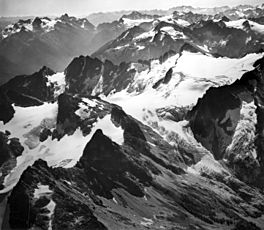Colonial Glacier facts for kids
Quick facts for kids Colonial Glacier |
|
|---|---|

View of Neve Glacier at right from the northeast as seen in 1971. The smaller Colonial Glacier is at left.
|
|
| Type | Alpine glacier |
| Coordinates | 48°39′43″N 121°08′20″W / 48.66194°N 121.13889°W |
| Length | .60 mi (0.97 km) |
| Terminus | Proglacial lake |
| Status | Retreating |
Colonial Glacier is a large river of ice found in North Cascades National Park. This park is located in the state of Washington in the U.S.. The glacier sits right next to a mountain called Neve Peak.
Colonial Glacier slowly flows generally north. It moves down from about 6,800 feet (2,070 meters) to 6,000 feet (1,830 meters) high.
Contents
Colonial Glacier: A Shrinking Ice Giant
Like many glaciers around the world, Colonial Glacier is getting smaller. Scientists have been watching it closely.
Where is Colonial Glacier?
Colonial Glacier is in the beautiful North Cascades National Park. This park is in the state of Washington, which is in the U.S.. The glacier sits on the northwest side of Neve Peak. It is part of the amazing mountain scenery there.
What's Happening to Colonial Glacier?
Between 1950 and 2006, Colonial Glacier shrank a lot. It is estimated to have retreated, or melted back, by more than 300 meters (about 984 feet). That's like losing the length of three football fields!
As the glacier melted, a new lake formed. This lake is called a proglacial lake. It now fills the space where the end of the glacier used to be. This area was once covered by a pile of rocks and dirt left by the glacier, called a terminal moraine.
Why Does This Matter?
The glaciers in the North Cascades are an important source of water. In the summer, their meltwater flows into rivers. This water helps keep a steady supply of electricity coming from hydroelectric power plants. These plants use the force of moving water to make electricity.
If the glaciers keep shrinking, there will be less meltwater in the summer. This could affect how much electricity these power plants can make. It also impacts the local environment and water supply.


